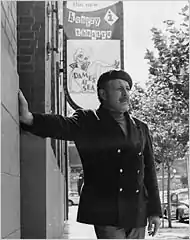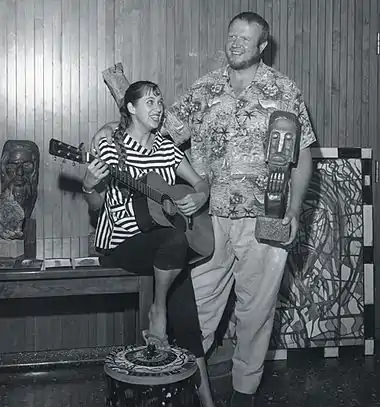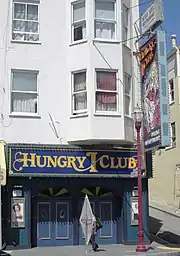hungry i
The hungry i was a nightclub in San Francisco, California, originally located in the North Beach neighborhood. It played a major role in the history of stand-up comedy in the United States.[1] It was launched by Eric "Big Daddy" Nord, who sold it to Enrico Banducci in 1951. The club moved to Ghirardelli Square in 1967 and operated mostly as a rock music venue until it closed in 1970.

Name
How the club's name came about is something of a mystery. According to one story, the lower-case "i" was meant to represent "intellectual". Banducci swore that it was Freudian and was short for "the hungry id". In another story, the sign was not finished in time for the club's opening, and next-day reviews in the San Francisco papers cemented the name for all time. "I was going to call it the Hungry Intellectual, but I ran out of paint" for the sign, Nord would tell interviewers. In another story, artist Mark Adams came up with the name.[2] "It (the lowercase 'i') designated the first-person singular, with all of its various cravings," he explained in a 1985 interview quoted in a 2007 obituary for him.[2][3]

Club
The hungry i was founded in 1949 or 1950 as an 83-seat venue in the Sentinel Building's basement at the corner of Kearny and Columbus, by Eric Nord, who sold it to Banducci in 1951.[1] After operating it as a venue for folk singers including Stan Wilson, Banducci began hiring comedians in 1953 with Mort Sahl, encouraging them to express themselves freely.[1] Their success caused queues around the block, until Banducci moved the hungry i to the nearby International Hotel (nicknamed "the I-Hotel") on Jackson Street in 1954.[4][1]
The hungry i and Banducci were instrumental in the careers of actor/comic Ronnie Schell, comic Bill Cosby, comic Lenny Bruce, and minister Malcolm Boyd. Musically, The Kingston Trio recorded two noted albums at the hungry i,[5] including the first live performance of their version of "The Lion Sleeps Tonight". Tom Lehrer's final satirical album That Was the Year That Was (1965) was also recorded there, as well as The Limeliters' album Our Men in San Francisco (1963).
Jazz pianist Vince Guaraldi,[6] folk singer Glenn Yarborough, the Gateway Singers, and comedians Godfrey Cambridge, Professor Irwin Corey, Joan Rivers and Mort Sahl were also given career boosts from their appearances at the hungry i, as well as Dick Cavett and Woody Allen. The folk-rock group We Five were signed to A&M records after Herb Alpert saw them perform there.
John Phillips and his group The Journeymen were the house band in the early '60s. Phillips would later achieve fame with The Mamas & the Papas.
The young Barbra Streisand begged Banducci for a single night at his nightclub, insisting that she would soon be a huge star. Banducci agreed to sign the singer, who had never performed professionally but was soon starring in I Can Get It for You Wholesale on Broadway. The resulting concerts (March–April 1963) were well-attended, giving Streisand nationwide acclaim.[7]
On 16 January 1967, Laura Nyro started her debut live performances at the hungry i.[8] Later in the same year, Ike & Tina Turner performed at the club and a photograph of Tina Turner by Baron Wolman was used for the cover of the second issue of Rolling Stone magazine.[9]
The comedy and folk music scene wilted in the mid-1960s. On 12 October 1967 Banducci closed the club at its International Hotel location and moved to Ghirardelli Square; it was mainly a rock music venue, and closed in 1970.[6] Banducci and many of the club's performers, including Mort Sahl, Jonathan Winters, Professor Irwin Corey, Jackie Vernon, and many others, reunited in 1981 for a one-night performance, which also featured film of the late Lenny Bruce. The event was captured for the nationally televised documentary hungry i Reunion, produced and directed by Thomas A. Cohen and featuring reminiscences by Bill Cosby, as well as by Maya Angelou, who had frequently performed there in the guise of a Caribbean singer at the beginning of her career.

Exhibition
An exhibition on the history of the hungry i opened March 28, 2007 at the San Francisco Performing Arts Library, now the Museum of Performance & Design, and was on view through August 25, 2007. Alumni who performed at the hungry i during its heyday—as well as club owner Enrico Banducci and his daughter—gathered for an opening celebration March 27. Among those reminiscing about their appearances at the club were Orson Bean, Shelley Berman, Father Malcolm Boyd, Travis Edmonson, Tom Lehrer, The Kingston Trio, Mort Sahl, Ronnie Schell, Ernie Sheldon, and Glenn Yarborough.
Radio
The San Francisco radio station KGO broadcast several talk shows live before an audience from the hungry i in the 1950s and '60s, notably hosted by Les Crane and Ira Blue. Mort Sahl was KGO's overnight announcer in the 1950s.
References
- McLellan, Dennis (2007-10-16). "Enrico Banducci, 85; owned hungry i nightclub". Los Angeles Times. ISSN 0458-3035. Retrieved 2016-05-23.
- Steinberg, Steve (March 2006). "Famed Artist Mark Adams Leaves Behind a Rich Tapestry of Color and Glass". Noe Valley Voice.
- Nolte, Carl (October 9, 2007) "Enrico Banducci: 1922-2007 The impresario of North Beach" (obituary) San Francisco Chronicle Retrieved October 20, 2011
- "Vince Guaraldi Timeline". Retrieved February 11, 2017.
- …from the "Hungry i"
- "Vince Guaraldi Timeline". Retrieved February 11, 2017.
- 'hungry i' at Barbra Archives website
- "Record World cover" (PDF). www.americanradiohistory.com.
- "Why Does Rolling Stone Love Baron Wolman So Much?". SantaFe.com. June 17, 2015.
External links
| Wikimedia Commons has media related to Hungry i. |
- Interview about 'hungry i' exhibit at the San Francisco Performing Arts Library & Museum (March 2007)
- Enrico Banducci, Bar School, and a Guy From Fresno via CoastNews.com
- Farewell Favorites: Enrico Banducci and the hungry i: Five Pages
- Dorothy Currin at Enrico Banducci's hungry i (scroll down)
- Enrico Banducci and the hungry i - BBC Programme Catalogue
- "The hungry i Reunion" TV show, The New York Times (February 10, 1982, original review September 18, 1981)